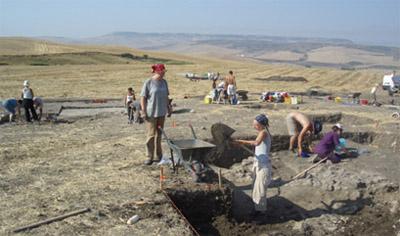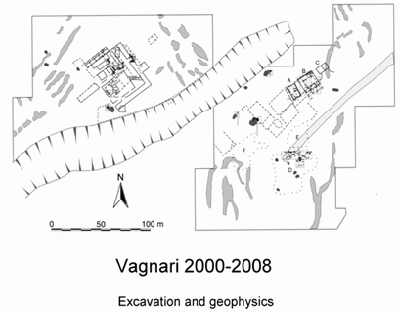Excavations at Vagnari
Vagnari is situated in the territory of the medieval-modern town of Gravina in Puglia, about 60 km south west of BARI (the provincial capital) in South Italy.

It is an area of rolling grain lands a little to the east of the Apennine mountains. The most famous of the Roman roads, the Via Appia passed close by. The site is divided in two by a ravine.
The earliest occupation at Vagnari was a small settlement (small village or large farm) founded in the 4th century BC, on the north side of the ravine. It is attested by surface material (black and grey glazed sherds), which shows that it occupied a maximum of 1000 square metres. Around the beginning of the 1st century AD, the settlement was acquired by the Roman emperor, together with a surrounding estate (which was very large) and was rebuilt on a much larger scale to serve as the economic centre of the area. Various industries were established there, especially tile-making and iron-working.
In the late 1st century the settlement, by now probably a vicus, i.e. a village with its own administrative structure, was rebuilt slightly lower down the slope towards the ravine. On the other side of the ravine there was the cemetery of the community. The village decayed in the 3rd century AD but in the Late Antique period (4th-6th centuries AD) it was re-organized again with the addition of large new buildings south of the ravine.
The project is a multi-faceted exploration of the site and its environs. The dimensions and main building lines of the settlement have been identified by surface collection and geophysical exploration (resistivity and magnetometry); and numerous trial trenches have been dug to test and amplify the results.
The earliest structures excavated include two tile kilns of the early 1st century AD. Loosely associated with one of these was a fragment of a tile stamped ‘Gra[ti Caes[aris' (of Gratus, the slave of Caesar), It can be dated to the Julio-Claudian period and provides good evidence for the Emperor's having owned the site at this time. Four other tiles of Gratus have been found in the surrounding area.
The settlement of the 2nd century AD to the north of the ravine consisted of a large orthogonally planned complex measuring ca. 45 x 60 m revealed by the resistivity survey, with a courtyard and several ranges of buildings, including a row of small cells which were perhaps sleeping quarters for slaves. Excavation has confirmed the accuracy of this plan at several points and provided evidence for iron working. There were also two tile kilns of this period, both located in the south part of the site between the ravine and the cemetery.

The Late Antique structures excavated on the south side of the ravine include another smithy, and a large building with a columned portico and inner covered yard, probably a market building. Two further tile kilns excavated south of the ravine can be dated to this phase.
The magnetometer survey has identified other possible kilns on both sides of the ravine.
The excavations in the cemetery have revealed seventy-three burials as of the end of 2008, all but two of them inhumations. Most date between the late 1st and early 3rd century AD, but a few are of the 4th century. A full osteological analysis is in progress together with a study of the grave goods and funerary rituals.
The archaeological field survey of the Basentello valley has made it possible to identify approximately the area of the imperial estate of which Vagnari formed a part, which must have extended over ca. 25 square kilometres. Most of the estate was devoid of habitation in the early empire and must have been given over to forest and rough grazing. In Late Antiquity part of it was subdivided into small holdings, attested by Late Roman Painted Ware (ceramica di Calle ) characteristic of the region.
So far the evidence suggests that Vagnari was a settlement of artisans and lower status individuals. The most likely location for the house of the imperial procurator who would have managed the estate is up the hill near the top of the plateau now called San Felice where a building provisionally interpreted as a villa is being excavated by a Canadian team directed by Hans vanderLeest (Mount Allison University) and Myles McCallum (St Mary’s University, Halifax).
Future plans
It is planned to continue the excavation in the cemetery in future years: this offers a rare chance to study a relatively isolated working population of the Roman period in the context of the settlement where they lived and worked. A limited excavation is also proposed for 2009 in the orthogonal structure north of the ravine in order to clarify some details of the plan.
Publications
A.M.. Small (2003), "New evidence from tile stamps for imperial properties near Gravina, and the topography of imperial estates in South East Italy", Journal of Roman Archaeology 16 (2003) 301-321. (With Appendix by V. Volterra and R.G.V. Hancock).
C.M. and A.M. Small (2005), “Defining an imperial estate: the environs of Vagnari in South Italy”, in P. Attema, A. Nijboer, A. Zifferero (eds) Communities and Settlements from the Neolithic to the Early Medieval Period, Volume II, Proceedings of the 6th Conference of Italian Archaeology, University of Groningen April 15-17, 2003. Oxford, BAR, 894-902.
P. Favia, R. Giuliani, A.M. Small, C.M. Small (2005), “L’insediamento rurale di Vagnari e la valle del Basentello in età tardoantica”, in G. Volpe, M. Turchiano (eds), Paesaggi e insediamenti rurali in Italia meridionale fra Tardoantico e Altomedioevo, Atti del Io seminario sul Tardoantico e l’Altomedioevo in Italia Meridionale (Foggia 12-14 febbraio 2004), Bari, Edipuglia, 2005 [2006], 193-222.
A.M. Small (2006) “The Production and distribution of bricks and tiles in South Italy: the evidence of Vagnari,” in W. V. Harris and E. Lo Cascio (eds) Noctes Campanae. Studi di storia antica ed archeologia preromana e romana in memoria di Martin W. Frederiksen (Naples: Luciano, 2005 [2006]) 191-211.
A.M Small e C.M. Small (eds) (2007) “Excavation in the Roman cemetery at Vagnari in the territory of Gravina in Puglia 2002. with contributions by Alessandra De Stefano, Roberta Giuliani, Martin Henig, Kathryn Johnson, Philip Kenrick, Tracy Prowse, Alastair Small and Hans vanderLeest, Papers of the British School at Rome, 2007, pp. 123-229.

